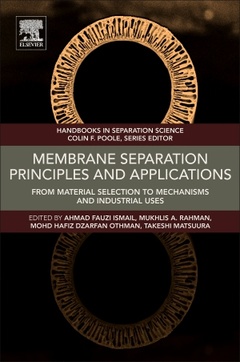Description
Membrane Separation Principles and Applications
From Material Selection to Mechanisms and Industrial Uses
Handbooks in Separation Science Series
Coordinators: Ismail Ahmad Fauzi, Rahman Mukhlis A., Othman Mohd Hafiz Dzarfan, Matsuura Takeshi
Language: English
Subjects for Membrane Separation Principles and Applications:
Keywords
Adsorptive membrane; Applications; Applications of ceramic and polymeric membranes; Azeotrope separation; Biocompatibility; Cellulose acetate; Characterization of inorganic membranes; Desalination; Draw solution; External concentration polarization; Fabrication; Fabrication techniques; Forward osmosis; Forward osmosis mode; Gas separation; Heavy metal; Hemodialysis; Hemodialysis membrane; Hybrid PV/VMD membrane; Hybrid technology; Hydrophilic PV membrane; Hydrophobic; Hydrophobic PV membrane; Hydrophobic VMD membrane; Inorganic membrane; Inorganic membrane preparation methods; Interfacial polymerization; Internal concentration polarization; Layer-by-layer inorganic filler; Materials selection; MBRs; Membrane; Membrane characterization; Membrane distillation; Membrane fabrication; Membrane fouling; Membrane fouling and control; Membrane materials; Membrane modification; Membrane module; Membrane modules; Membrane process; Membrane properties; Membrane technology; Membranes; Microfiltration; Mixed matrix membrane; Nanofiltration; Nanomaterials; Nanoparticles; Nanotechnology; Pervaporation; Petrosep membrane applications; Polymer; Polymeric membrane; Pressure-retarded osmosis; Reverse osmosis; RO applications; Separation mechanism; Structural parameter; Surface modification; Thin film composite; Thin film composite membrane; Ultrafiltration; Vapor permeation; Vapor separation; Water reclamation; Water treatment
494 p. · 15x22.8 cm · Paperback
Description
/li>Contents
/li>Readership
/li>Biography
/li>Comment
/li>
Membrane Separation Principles and Applications: From Material Selection to Mechanisms and Industrial Uses, the latest volume in the Handbooks in Separation Science series, is the first single resource to explore all aspects of this rapidly growing area of study. Membrane technology is now accepted as one of the most effective tools for separation and purification, primarily due to its simple operation. The result has been a proliferation of studies on this topic; however, the relationships between fundamental knowledge and applications are rarely discussed. This book acts as a guideline for those who are interested in exploring membranes at a more progressive level.
Covering methods of pressure driving force, partial pressure driving force, concentration driving force, electrical potential driving force, hybrid processes, and more, this volume is more complete than any other known resource on membrane separations.
2. Nanofiltration
3. Ultrafiltration
4. Microfiltration
5. Gas separation
6. Vapor separation
7. Pervaporation
8. Membrane distillation
9. Dialysis
10. Forward osmosis
11. Pressure retarded osmosis
12. Hybrid processes: Membrane adsorption
13. Hybrid processes: Membrane bioreactor
chemists and chemical engineers, professors, graduate students at research institutions and industry who are engaged in R&D of membranes for separation processes. Secondary: people studying gas separation, waste water treatment and water production, fuel cells, food processing, and policy makers.
Prof. Dr. Ahmad Fauzi Ismail is the Founder and First Director of Advanced Membrane Technology Research Centre (AMTEC). His research interest are in development of polymeric, inorganic and novel mixed matrix membranes for water desalination, waste water treatment, gas separation processes, membrane for palm oil refining, photocatalytic membrane for removal of emerging contaminants, development of haemodialysis membrane and polymer electrolyte membrane for fuel cell applications. His research has been published in many high impact factor journals. He also actively authored many academic books in this field which published by reputable international publishers. He is the author and co-author of over 600 refereed journals. He has authored 6 books, over 50 book chapters and 4 edited books, 6 Patents granted, 14 Patents pending. His h-index is 66 with cumulative citation of over 19,300. He won more than 150 awards national and internationally. Among the most prestigious award won is the Merdeka Award for the Outstanding
- Covers membrane material selection, membrane fabrication, membrane characterization, separation mechanisms and applications in each chapter
- Authored by contributors who are internationally recognized as experts in their respective fields
- Organized by the driving force behind each type of membrane separation—a unique approach that more clearly links fundamental principles with their dominant applications




